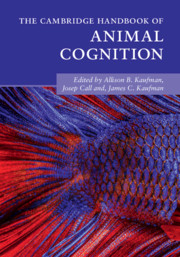Book contents
- The Cambridge Handbook of Animal Cognition
- The Cambridge Handbook of Animal Cognition
- Copyright page
- Dedication
- Contents
- Figures, Tables, and Boxes
- Contributors
- Acknowledgments
- Introduction
- Part I Communication and Language
- Part II Memory and Recall
- Part III Social Cognition
- Part IV Social Learning and Teaching
- Part V Numerical and Quantitative Abilities
- Part VI Innovation and Problem-Solving
- 28 Innovation and Problem-Solving Overview
- 29 General Intelligence (g) in Mice
- 30 Bowerbird Innovation and Problem-Solving
- 31 Parrot Innovation
- 32 Innovation in Marine Mammals
- 33 Innovation in Capuchin Monkeys
- 34 Innovation and Problem-Solving in Orangutans
- 35 Do Apes and Monkeys Know What They (Don’t) Know?
- 36 Decision Making in Animals
- Index
- References
31 - Parrot Innovation
from Part VI - Innovation and Problem-Solving
Published online by Cambridge University Press: 01 July 2021
- The Cambridge Handbook of Animal Cognition
- The Cambridge Handbook of Animal Cognition
- Copyright page
- Dedication
- Contents
- Figures, Tables, and Boxes
- Contributors
- Acknowledgments
- Introduction
- Part I Communication and Language
- Part II Memory and Recall
- Part III Social Cognition
- Part IV Social Learning and Teaching
- Part V Numerical and Quantitative Abilities
- Part VI Innovation and Problem-Solving
- 28 Innovation and Problem-Solving Overview
- 29 General Intelligence (g) in Mice
- 30 Bowerbird Innovation and Problem-Solving
- 31 Parrot Innovation
- 32 Innovation in Marine Mammals
- 33 Innovation in Capuchin Monkeys
- 34 Innovation and Problem-Solving in Orangutans
- 35 Do Apes and Monkeys Know What They (Don’t) Know?
- 36 Decision Making in Animals
- Index
- References
Summary
Parrots are sometimes referred to as "feathered apes,"` as they rival our closest relatives in many cognitive abilities. Similar to apes, they show a high propensity for innovative behaviour. Factors that were suggested to influence innovativeness are manifold. We discuss the various reasons why parrots might be particularly well-equipped to innovate. Many psittaciformes have ecological backgrounds that have been suggested to correlate with innovativeness, and recent neurological findings suggest a link between their brain anatomy and advanced cognitive abilities. The parrots’ beak has been described as a "multi-purpose tool" that allows them to employ a wide range of motoric interactions with different substrates, foods, or objects. Moreover, parrots generally approach novel situations with curiosity and caution, and explore in a haptic and playful manner, which presumably provides them with more opportunities to innovate. Studies on model species in innovative problem-solving, such as the kea and the Goffin’s cockatoos, highlight their sensitivity to changes in their environment and their ability to flexibly adjust to them. Multiple parrot species show tool innovations in captivity. However, controlled comparisons between captive and wild populations are still scarce. In summary, studying innovation in large-brained, non-primate models, such as parrots, will ultimately contribute to our understanding of the evolution of inventive minds.
- Type
- Chapter
- Information
- The Cambridge Handbook of Animal Cognition , pp. 690 - 709Publisher: Cambridge University PressPrint publication year: 2021

